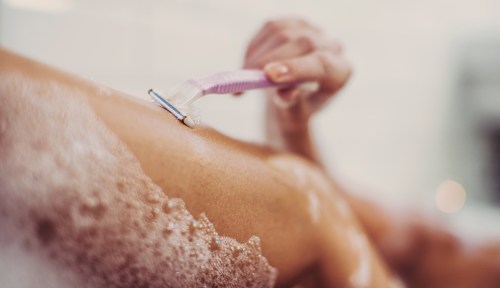Prevent Razor Bumps With These Simple Tips From a Dermatologist
Razor bumps impact anyone who shaves, and this dermatologist explains how to prevent them so that you have silky, smooth skin.

If you’ve ever shaved, you know razor bumps are pretty much inevitable. While no one else may be staring at them, you may not like them aesthetically. Like most things, there isn’t one perfect way to prevent razor bumps, and what works for you may not work for someone else, but there are a few simple steps you can implement instantly to prevent razor bumps.
Experts in This Article
board-certified dermatologist at Skin Wellness in Birmingham, Alabama
Medically called pseudofolliculitis, Dr. Corey L. Hartman, MD, FAAD, a board-certified dermatologist, and the medical director and founder of Skin Wellness Dermatology in Birmingham, AL, says the prefix, pseudo, refers to there not truly being inflammation of the hair follicle. “We see inflammation around these follicles not because there’s an infection, but because the curly, thick, coarse hair grows back into the follicle,” explains Dr. Hartman. As your hair grows, it’s protected by a sheath that compartmentalizes the hair follicle from the skin. “However, if that hair grows back in because it’s curly and it’s coarse and it’s thick, then it’s not protected [by the sheath]. And the skin sees that as something that it needs to fight against, an invader. And that’s why you get this pseudo inflammation. So it’s not really an infection, but it’s just angry and red.”
If you happen to have coarse, thick, curly hair, you’re more prone to experiencing razor bumps, according to Dr. Hartman. The same goes for those of Mediterranean, Black, and Middle Eastern descent, he says. But that doesn’t mean you can’t prevent razor bumps. One solution to prevent razor bumps is to “get rid of the hair with laser hair removal, so there’s no hair to grow, there’s nothing to curl,” or you can grow the hair out completely “where the hair is all the way expressed. It’s through the skin, so it’s not getting into that cycle where you’re cutting it and then it’s growing and curling in again,” he says. “Other than that, you’re managing the bumps.”
This Parisian Skincare Brand Is Launching in the United States for the First Time—Here’s What a Derm Wants You to Know

We’re Calling It: Cleansing Balms Are the Face Wash of the Future—Here Are 3 to Add to Your Cart

This Is the One Product That Scarlett Johansson Always Keeps in Her Purse and on Her Bedside Table

If you already have razor bumps, the first step in managing them, according to Dr. Hartman, is to learn how your hair grows (especially if you’re shaving your face or the genital area) and then cut the hair in that direction, not against it. This will prevent the hair from getting too short. He also recommends investing in a razor with minimal blades. Contrary to popular belief, the more blades, the higher the risk of razor bumps, says Dr. Hartman.
“If you do commit to a razor with more than one blade, you get one swipe at it [the hair], and then you’re done. Because every time you cut the hair, it retracts more and more into the skin. It gets shorter and shorter which will give you a great shave that one time, but then it gives you more work to do once the hair grows out,” he says. Not to mention, it’s more opportunity for the hair to get stuck as it grows out, for the hair to grow back in curlier, and for the skin to become inflamed, says Dr. Hartman.
He also advises using moisturizing shaving cream or gel which will allow the razor to glide over your skin with less friction. Using AHA and BHA cleansers and moisturizers exfoliate the skin, which will help prevent the hair from growing back in and causing razor bumps, Dr. Hartman says. “If there’s less dead skin, then there’s going to be fewer obstacles to growing in.” Shaving less, using products with benzoyl peroxide, and even topical steroids and anti-inflammatory steroids are also an option, but you’ll need to speak to a dermatologist for a prescription.
If you’re experiencing razor bumps that have begun to secrete pus, and the aforementioned management tips aren’t helping, Dr. Hartman advises working with a dermatologist who will more than likely prescribe some form of oral medication to further prevent discomfort, hyperpigmentation, and scarring you may be experiencing. It’s pretty hard to prevent razor bumps, but not impossible if you follow these simple tips.
Ready to get rid of your body hair once and for all? Here’s what you should know about laser hair removal:
Want even more beauty intel from our editors? Join Well+Good’s Fine Print Facebook group (and follow us on Instagram) for must-know tips and tricks.
Sign Up for Our Daily Newsletter
Get all the latest in wellness, trends, food, fitness, beauty, and more delivered right to your inbox.
Got it, you've been added to our email list.







